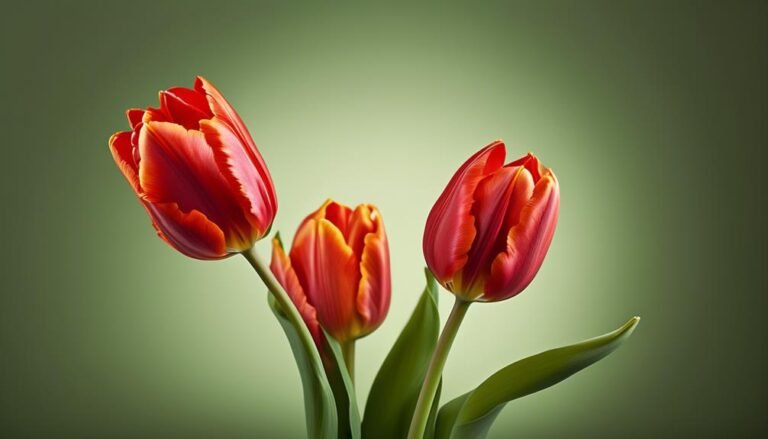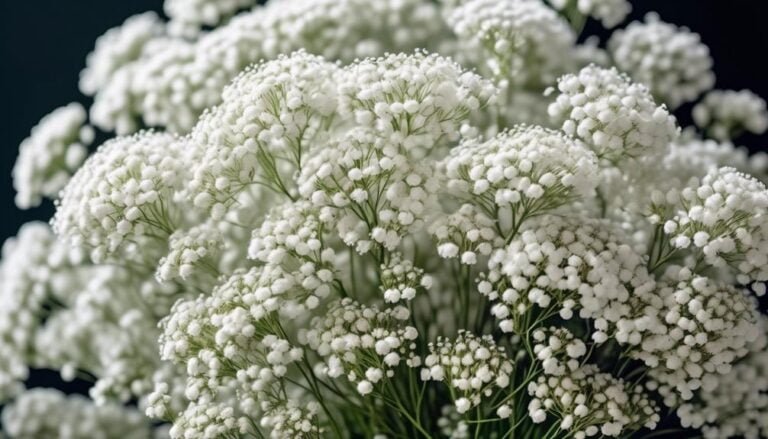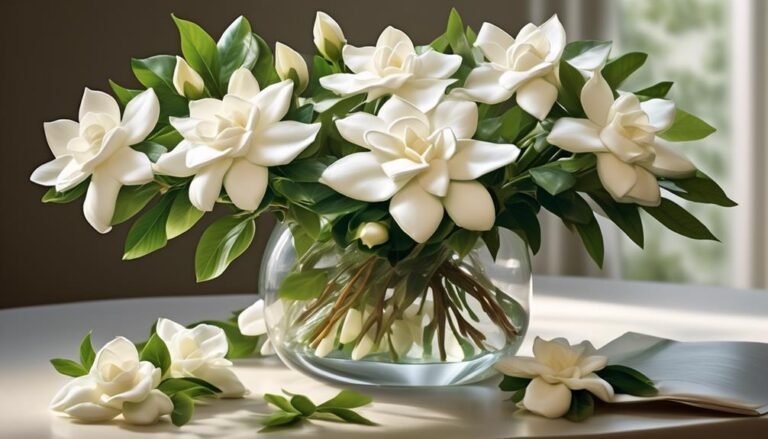Popular Types of Florist Flowers – Ranunculus
The ranunculus flower, known for its delicate layers and vibrant hues, is a perennial favorite among florists. This captivating bloom is scientifically named Ranunculus asiaticus and is widely available in the spring.
It requires moderate care, with a preference for well-drained soil and partial sunlight. The ranunculus adds depth and dimension to floral arrangements, making it a popular choice for weddings and special occasions.
Scientific Name
The Ranunculus asiaticus, commonly known as the ranunculus flower, belongs to the buttercup family, Ranunculaceae, and thrives in moist environments. Its genus name, Ranunculus, originates from the Latin word 'rana', meaning 'little frog', due to its preference for damp habitats. This flower has been classified within the Ranunculaceae family since ancient times, owing to its buttercup-like appearance.
Culturally, the symbolism of the ranunculus flower varies. In Greek mythology, it's linked to the story of Hyakinthos, with the flower, also called the 'windflower', believed to have sprung from his blood, symbolizing beauty arising from tragedy. In Persian culture, the ranunculus represents charm and attractiveness, and it's commonly used for ornamental and celebratory purposes.
The ranunculus flower holds enduring significance across diverse cultural contexts, reflecting its historical and symbolic importance.
Background History
The ranunculus flower, belonging to the buttercup family Ranunculaceae, has a rich historical and cultural significance. Its genus name is derived from the Latin word 'rana'. The flower holds a special place in ancient Greek and Roman mythology, often associated with the story of Adonis and Aphrodite, symbolizing love and attraction. This mythological connection has contributed to its enduring popularity and representation in various cultural contexts.
Ranunculus have been a popular subject in art and literature, symbolizing themes such as love, beauty, and the cycle of life. Their vibrant colors and delicate blooms have made them a favorite in paintings, sculptures, and poetry, reflecting their symbolic importance in artistic expression.
Cultivated for centuries, ranunculus were favored in Persian gardens during the Achaemenid period, showcasing their historical significance in horticulture. In the 16th century, they gained prominence in Europe, particularly in the Netherlands, where they became a staple in ornamental gardens and floral arrangements, further solidifying their cultural and historical relevance.
The historical significance of ranunculus in diverse cultural contexts and their symbolic representation in art have contributed to their enduring popularity and timeless appeal in the world of floristry and horticulture.
Physical Description
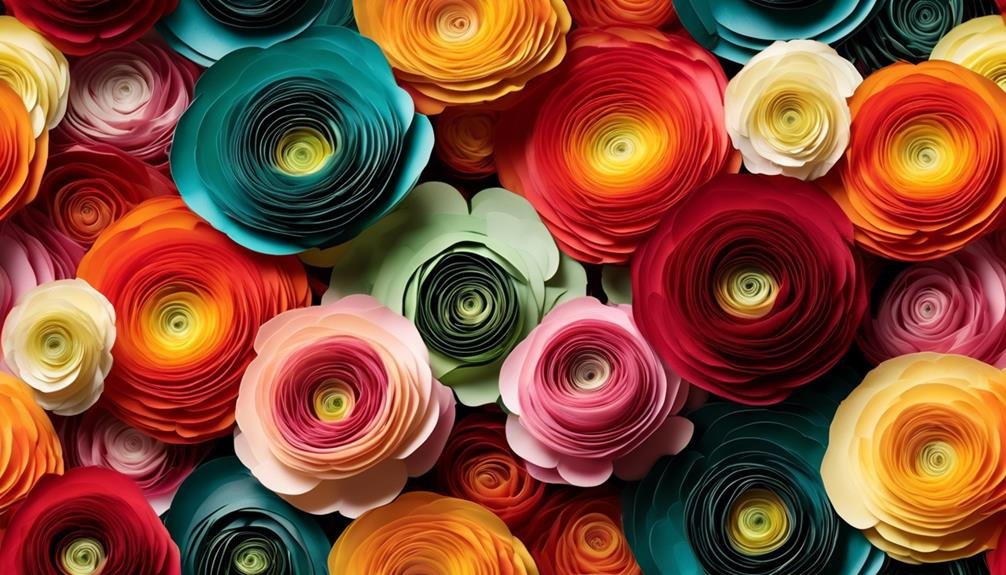
Ranunculus flowers are known for their fluffy, multi-petaled appearance and wide range of colors, resembling a rose but with thinner petals. They typically measure 2-3 inches wide and come in various colors, from soft pastels to vibrant hues, making them versatile for floral arrangements. The long and sturdy stems of ranunculus make them suitable for use in different floral designs and arrangements.
Cultivation-wise, ranunculus flowers thrive in well-drained soil and full sun. They're typically planted in the fall for spring blooms and require a period of cold dormancy to flourish. Symbolically, ranunculus flowers represent charm, attractiveness, joy, and admiration, making them popular for romantic gestures, declarations of love, and celebratory occasions like weddings.
Colours and Characteristics
Ranunculus flowers are known for their vibrant array of colors and unique characteristics, making them a popular choice for various uses.
Ranunculus Asiaticus comes in lively hues such as red, yellow, orange, and pink, offering a wide spectrum of colors to choose from.
The Ranunculus Hanoi features delicate pink petals, reminiscent of cotton candy and marshmallows, adding a touch of delicacy to floral arrangements.
In contrast, the Ranunculus Tango showcases sultry and vibrant ruby petals, providing a unique alternative to traditional rose bouquets and thriving without pesticides.
These flowers are versatile and can be used in bridal bouquets, home decor, and luxury floral arrangements.
Their unique hues make them perfect for conveying different symbolic meanings.
For example, the Ranunculus Venere showcases a hue between pink and coral, capturing the essence of a perfect sunset and adding warmth to any indoor space.
This makes them ideal for expressing sentiments of admiration, warmth, and affection in floral arrangements.
Florists often combine ranunculus flowers with other blooms for a lavish display, adding a pop of color and luxury to their arrangements.
Varieties Available
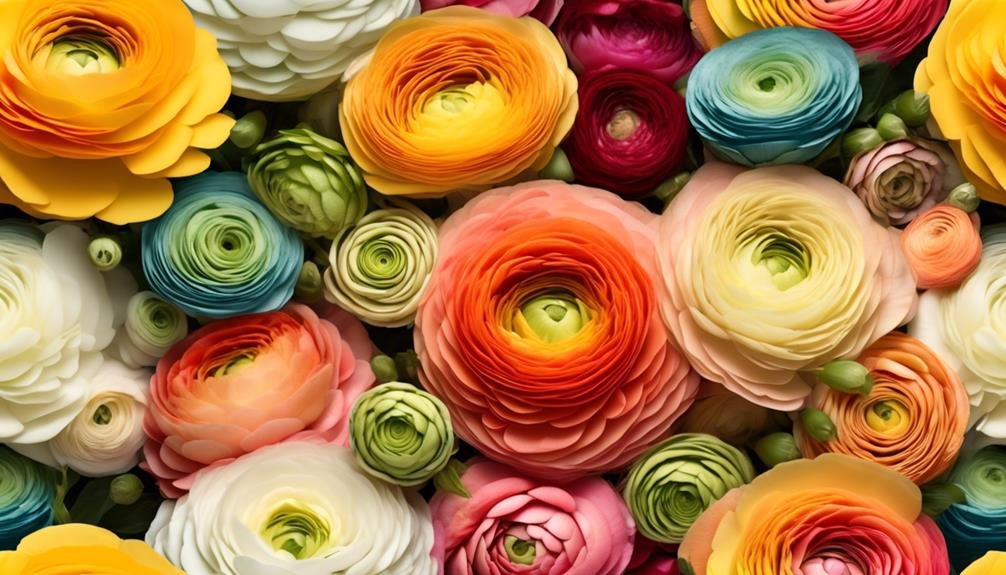
Ranunculus Varieties for Floral Arrangements
Ranunculus varieties offer a diverse range of characteristics and visual appeal for florists and enthusiasts. When choosing which varieties to include in floral arrangements, it's important to understand the unique features of each type.
Here are some popular ranunculus varieties and their key attributes:
Italian Butterfly: This variety is known for its vibrant colors and intricate, ruffled petals.
Japanese Butterfly: Similar to the Italian variety, the Japanese Butterfly offers a wider range of colors.
Elegance: A budget-friendly option with a wide range of available colors.
Cultivation techniques can vary slightly depending on the variety, but in general, ranunculus thrive in well-draining soil and require regular watering.
When incorporating these flowers into floral arrangements, consider their varying heights and color palettes. Italian and Japanese Butterfly ranunculus make stunning focal points with their vibrant colors and intricate petals. The budget-friendly Elegance variety offers a wide range of colors and is suitable for different climates, making it a versatile choice for various floral designs.
When sourcing ranunculus corms for cultivation, it's essential to obtain them from commercial growers or reputable retailers to ensure the quality and robustness of the plants.
Seasonal Availability
Ranunculus, with their vibrant colors and delicate blooms, have a seasonal availability that closely relates to cultivation and varieties. Understanding this relationship is crucial for planning floral arrangements. Factors influencing ranunculus availability include temperature, geographical location, and planting schedule.
In warmer climates, ranunculus blooms can be expected from late winter to spring, while in cooler climates, they may bloom from spring to early summer.
To extend the blooming season of ranunculus, consider the following tips:
- Temperature: Ranunculus thrive in cool temperatures, so providing some shade and cooler conditions can help extend their blooming season. In warmer climates, planting them where they receive morning sun and afternoon shade can create a more favorable environment.
- Watering: Consistent and adequate watering is essential for prolonged blooming. Ranunculus prefer moist, well-drained soil, so regular watering, especially during dry spells, can help keep them blooming for a longer period.
- Soil Quality: Ensuring that the soil is rich in organic matter and well-aerated can contribute to a longer blooming season for ranunculus. Amending the soil with compost and ensuring proper drainage can promote healthy growth and prolonged flowering.
Understanding the seasonal availability of ranunculus and the factors that influence it allows florists to plan and create stunning arrangements year-round. By considering the local climate, temperature, and planting conditions, it's possible to extend the blooming season of ranunculus and enjoy their vibrant colors and delicate blooms for a longer period.
Care Tips

Ranunculus Care Tips: How to Ensure Healthy Growth and Blooming
Soil and Sunlight: Ranunculus flowers thrive in well-drained soil and require all-day sun for optimal growth and blooming.
Companion Planting: Daffodils make great companions for ranunculus as they repel common pests like aphids and provide a barrier against burrowing pests. Thyme is also a good companion plant as it helps deter harmful insects like spider mites.
Pest and Disease Management: Keep an eye out for pests such as aphids, snails, and slugs, which can damage the blooms and foliage. Powdery mildew can be a concern, especially in conditions with poor airflow. Ensure proper airflow and optimal growing conditions to prevent diseases.
Planting and Maintenance: Soak the corms in room temperature water before planting to wake them up. Plant the corms 2 inches deep and 5 inches apart for healthy growth. Regular deadheading can help prolong the blooming period.
Cut Flower Care: When using ranunculus as cut flowers, cut the stems at the base of the plant, remove side buds if desired, and strip leaves below the water level in the vase to prolong vase life.
Can Ranunculus and Gypsophila Be Used Together in Floral Arrangements?
Yes, Ranunculus and Gypsophila can absolutely be used together in floral arrangements. The delicate blooms of Ranunculus complement the airy, wispy texture of Gypsophila, creating a beautiful and romantic look. When combined, these popular gypsophila florist flowers can add depth and elegance to any bouquet or centerpiece.
Conclusion
Ranunculus flowers are a popular choice among florists for their multi-petaled blooms and wide range of colors. They're adaptable to garden or container growth, requiring well-drained soil and full sun.
With their association with charm and attractiveness, and a vase life of 7-10 days, Ranunculus flowers are an excellent choice for conveying messages of love, admiration, and joy.

